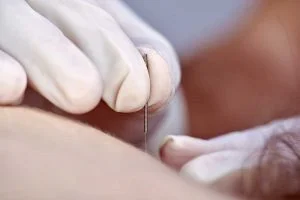Dry needling is a type of needle-based therapy that targets muscle tissue. The goal of undergoing dry needling therapy is to reduce pain, deactivate trigger points, and restore proper balance and function. Dry needling doesn’t usually occur by itself but as a component of a larger plan of treatment with multiple procedures to achieve a greater goal.
When you engage in dry needling treatments, the physical therapist uses a thin filiform needle that permeates your skin. It causes the stimulation of myofascial trigger points beneath the skin and the connective and muscular tissues. This particular needle lets the PT access tissues that aren’t usually palpable.
Always check with your primary care physician if you’re unsure whether dry needling is the proper treatment for your muscle pain or general pain.
Acupuncture and Dry Needling Are Not the Same
The ideology behind acupuncture is different from that of dry needling. Dry needling is derived from Western medicine practices, while acupuncture comes from Chinese traditions.
Additionally, acupuncture focuses more on balancing the flow of energy throughout your body to relieve pain and discomfort.
Dry Needling Can Treat Both Pain and Mobility Problems
Though dry needling primarily addresses pain, you can also try it to help alleviate mobility impairments. If you suffer from limited mobility because of scar tissue and restrictions from the connective tissue that forms the tendons, dry needling can help.
Needling may reduce myofascial pain in several areas, thanks to its efficiency. These are the conditions caused by the most common trigger points:
- Sciatica
- Migraines and headaches
- Pain in the lower back
- Pain in the knees, shoulders, hips, and neck
- Carpal tunnel
- Groin, muscle, and hamstring strains
- Osteoarthritis
- Tennis elbow, golfer’s elbow, tendonitis, and other injuries resulting from overuse
- Fibromyalgia
You May Experience Some Muscle Discomfort
It’s not uncommon for someone to fear needles, even if they don’t cause any pain. Speak with your physical therapist if you want to be 100 percent sure about proceeding with dry needling.
The thin filiform needles used during dry needling are solid, and they can typically penetrate the upper layer of skin with almost no sensation whatsoever. After the needle is in place, your muscle tissues have a distinct response.
They’ll inadvertently begin contracting, much like when you get a Charlie horse (cramp). It only lasts for a couple of seconds, but it is uncomfortable when it occurs. Afterward, that myofascial pain should dissipate. Once the session is complete, you might experience slight bruising or mild discomfort.
What Are Trigger Points?
It’s essential to understand trigger points since one of the significant aspects of dry needling is to make them inactive. A trigger point is an area of the muscle that is very sensitive, painful when you push it, and consists of taut fascial/muscular banda that inhibits oxygenated blood flow.
Overtraining your muscles or an instance of direct trauma may be the culprit as to why trigger points develop in the first place. Once the muscle has surpassed the ability to cope with stress, trigger points may form.
Dry needling is unique because it emphasizes the stimulation of the trigger points to release tension in that spot, thereby relieving pain.
It Will Takes At Least Several Sessions Before You See Results
You shouldn’t expect to see results after just one session. Typically, a minimum of two to three visits will start to yield noticeable results that last. Your muscles feel relaxed in the beginning before returning to pain or discomfort.
Multiple treatments will eventually retrain your muscles to have a different neuro-muscular response. Your proper functioning gets restored after a while, depending on the severity of the pain.
No matter what, though, know that the physical therapy that Mid-County Physical Therapy provides can certainly help you get to a better spot. Call us today to schedule your consultation.


